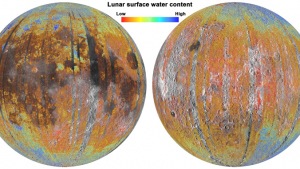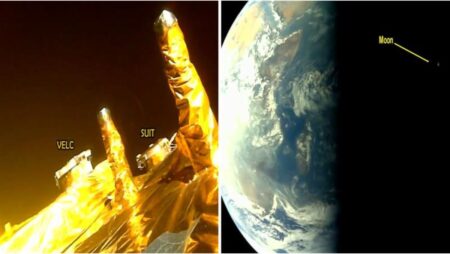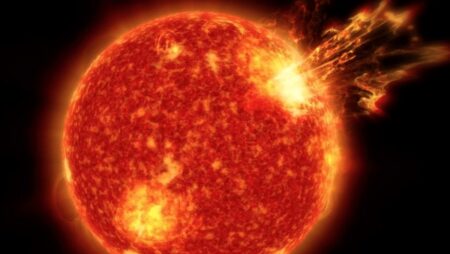In a groundbreaking study published in the journal Nature Astronomy, researchers from the University of Hawai’i at Manoa, in collaboration with data from India’s Chandrayaan-1 lunar mission, have unveiled a remarkable discovery regarding the Moon’s water formation process. This revelation challenges previous assumptions and provides critical insights into the Moon’s formation, evolution, and the potential for future human exploration and water resource provision.
Chandrayaan-1’s Pivotal Role
India’s Chandrayaan-1 lunar probe, launched in 2008, played a pivotal role in unlocking some of the Moon’s long-held secrets. While the solar wind, composed of high-energy particles like protons, had been the focus of lunar water formation research, this study delved deeper. It explored how the Moon’s surface reacts when it traverses Earth’s magnetotail, an area that offers partial protection against solar wind but not the Sun’s photons.

ALSO READ: Chandrayaan-3: Canadian Astronaut Reacts to Vikram’s Lunar Descent Pauses
Shuai Li, an assistant researcher at UH Manoa School of Ocean, emphasized the unique properties of Earth’s magnetotail, stating, “This provides a natural laboratory for studying the formation processes of lunar surface water.” Surprisingly, the study found that the water formation process within Earth’s magnetotail closely resembled that outside of it, challenging previous assumptions.
Electrons: A New Player in Lunar Water Formation
The study suggests that high-energy electrons present in Earth’s plasma sheet, a region of charged particles within the magnetosphere, might be contributing to weathering processes on the lunar surface and potentially aiding in the formation of water. The magnetosphere, influenced by the solar wind, plays a crucial role in protecting Earth from space weather and radiation from the Sun.
As the solar wind pushes the magnetosphere and reshapes it, a long tail forms on the night side, similar to what happens with comets. This tail region, known as the plasma sheet, contains high-energy electrons and ions from Earth and solar wind. Researchers built upon previous work that showed how oxygen in Earth’s magnetotail rusts iron in the lunar polar region and decided to investigate changes in surface weathering as the Moon passed through this unique region.
Analyzing Data from Chandrayaan-1
To unravel these mysteries, the researchers utilized data collected by the Moon Mineralogy Mapper instrument onboard Chandrayaan-1 between 2008 and 2009. Their analysis focused on changes in water formation as the Moon passed through Earth’s magnetotail. Intriguingly, they discovered that water formation in the magnetotail appeared to be identical whether the Moon was within it or not. This finding hints at the existence of water formation processes or sources that are not directly associated with solar wind protons.
Implications for Lunar Exploration
The implications of this discovery are profound, with direct relevance to future lunar exploration efforts. Understanding the mechanisms behind lunar water formation is crucial for planning sustainable human missions to the Moon. Water is not only essential for drinking and irrigation but can also be converted into oxygen and hydrogen for life support systems and rocket fuel, respectively. With this newfound insight into the role of high-energy electrons, future lunar missions can refine their plans for harnessing lunar water resources.
A Cosmic Connection
Perhaps one of the most remarkable aspects of this research is the revelation of the profound connection between Earth and its Moon. The Moon, long considered a barren and isolated celestial body, is now shown to be intimately influenced by Earth’s magnetosphere and its high-energy electrons. This cosmic relationship highlights the intricate interplay between celestial bodies in our solar system and underscores the need for further exploration and understanding of these complex interactions.
Thus, the collaborative efforts of researchers from the University of Hawai’i at Manoa and data from India’s Chandrayaan-1 mission have illuminated a fascinating facet of lunar science. High-energy electrons in Earth’s plasma sheet, previously overlooked, appear to play a significant role in the formation of water on the Moon. This discovery challenges existing theories and opens new doors for lunar exploration and resource utilization. As humanity looks toward future lunar missions, the Moon’s mysteries continue to unravel, revealing the profound cosmic connections that shape our understanding of the universe.
You can find the report here: https://www.hawaii.edu/news/2023/09/14/earths-electrons-moon-water/













